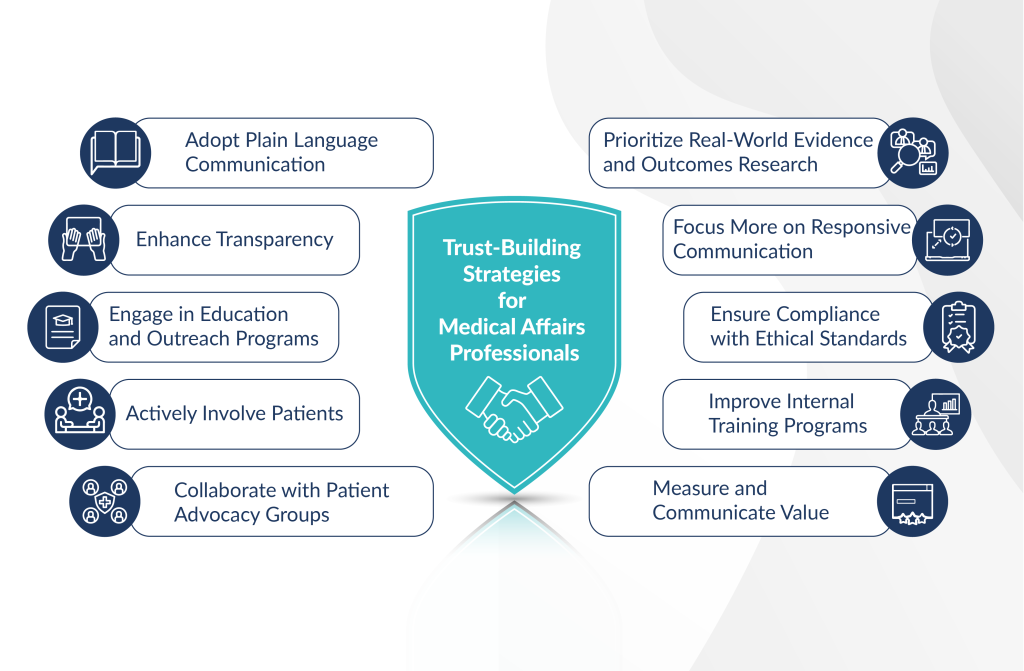Across 21 countries, Ipsos surveys reveal that, on average, 34% of adults consider pharmaceutical companies trustworthy, a slight increase from the 31% reported in 2021. This trend reflects the ongoing pattern observed in the sector over recent years. In response to this growing need for trust restoration within the pharmaceutical industry, a transformative shift toward plain language communication is underway. This strategic move aims to rebuild public perception by demonstrating an unwavering commitment to clarity, honesty, and ethical practices. The industry faces mounting pressure to enhance transparency and accountability in light of escalating incidents of misinformation, drug recalls, and controversies.
Simultaneously, there is an emphasis on patient empowerment, aligning with the broader trend of positioning patients as active participants in their healthcare journey. The imperative to address health disparities, which are often rooted in limited access to clear information, adds urgency to this shift. Moreover, regulatory bodies are focusing on the need for clear and transparent communication. The pharmaceutical sector grapples with public skepticism, prompting a concerted effort to rebuild trust through transparent, ethical, and patient-centric practices. This article explores related challenges and proposes strategies to navigate this evolving landscape.
What challenges must pharma tackle for trust, patient empowerment, and transparent communication?
Developing plain language communication is a proactive response to the erosion of trust. By adopting clear, accessible, and consistent language, pharmaceutical companies can engage and empower the public, rebuild credibility, and contribute to a more transparent and patient-centric healthcare environment.
- Trust Erosion and Industry Perception: Declining positive perceptions of pharmaceutical and healthcare industries in 2023 emphasize the urgency for transparent communication to rebuild public trust. Clear and transparent communications are essential for combating misinformation, particularly in environments where trust levels are low.
- Patient Empowerment: Key drivers like economic fears and polarization underscore the importance of empowering patients with comprehensible information, which can be achieved through plain language communication.
- Social Media Impact and Scrutiny: With social media’s outsized influence on health decisions, utilizing plain language communications becomes crucial to combat misinformation and ensure accurate understanding. Moreover, the growing pressure on social media to remove false health information underscores the need for clear language to overcome barriers caused by misinformation and ensure accurate health information dissemination.
- Retail Healthcare Trends: As retail healthcare grows, ensuring patients understand their care journey is essential to prevent fragmentation and hurdles in their journey and in the provision of the required treatment and care, making clear communication pivotal.
- Consumer Disconnect: Rising healthcare costs cause more consumers to disconnect from the healthcare system, creating a need for transparent pricing that can be easily understood by the average healthcare consumer.
- Provider Trust Building: Positive patient-provider relationships facilitated by clear communication are integral to earning patient trust. Medical Affairs can help healthcare providers (HCPs) do this by providing easy-to-understand modular content and disseminating it using an omnichannel approach to appeal to various types of learners.
- Future Healthcare Models: Medical debt and rising prices will drive consumers toward providers that offer transparent pricing through subscription-based healthcare bundles. These subscriptions will require easy-to-grasp pricing structures and benefit communications, as most interactions will be non-personal.
What can Medical Affairs professionals do to build public trust?
Medical Affairs professionals can contribute significantly to rebuilding trust in the pharmaceutical industry by fostering positive relationships with HCPs, patients, and the wider community. Here’s how:

- Adopt Plain Language Communication: Simplify complex medical information for HCPs and the public (educational materials, package inserts, and other documents for diverse audiences).
- Enhance Transparency: Openly share information about research, drug development processes, and clinical trial outcomes, as well as the benefits, limitations, and potential risks associated with pharmaceutical products.
- Engage in Education and Outreach Programs: Seminars, workshops, webinars, and written materials that focus on health literacy, disease prevention, and treatment options. Engaging with communities directly can help dispel myths and address concerns.
- Actively Involve Patients: Actively involve patients in decision-making processes, seek their input on clinical trial designs, and incorporate patient perspectives into healthcare communication.
- Collaborate with Patient Advocacy Groups: Help develop more patient-friendly materials, provide accurate information, and establish channels for ongoing communication.
- Prioritize Real-World Evidence and Outcomes Research: Invest in real-world evidence and outcomes research to demonstrate the effectiveness and safety of pharmaceutical products in real-world settings.
- Focus More on Responsive Communication: Establish channels for open communication, such as helplines, online forums, or social media platforms, to address questions, emerging issues, and concerns in real time.
- Ensure Compliance with Ethical Standards: Compliance with industry regulations not only maintains the integrity of Medical Affairs practices but also reinforces the commitment to ethical conduct, building confidence among stakeholders.
- Improve Internal Training Programs: Conduct internal training programs for Medical Affairs professionals to enhance their communication skills, specifically on how to convey complex information in a simple and understandable manner and emphasize the importance of empathy in patient interactions.
- Measure and Communicate Value: Clearly communicate the value that Medical Affairs brings to the organization and, ultimately, to patients. Highlight contributions in areas such as medical education, scientific exchange, and evidence generation to underscore the commitment to advancing healthcare outcomes.
In summary, embracing clear and concise plain language communication is a proactive strategy to engage and empower the public amidst the trust crisis in the pharmaceutical industry. Medical Affairs professionals play a crucial role in implementing strategies such as adopting plain language, enhancing transparency, and prioritizing patient-centric approaches. By addressing the above-mentioned issues and adapting to changing healthcare models, the industry can rebuild trust, empower patients, and contribute to a transparent and patient-centric healthcare future.
About the author

Kwisha Shah
Kwisha Shah is Marketing Content Manager, Thought Leadership, at Cactus Life Sciences.













